Philips IntelliVue MP40, IntelliVue MP50, IntelliVue MP60, IntelliVue MP70, IntelliVue MP90 User manual

IntelliVue MP40/50 and MP60/70/90
INSTRUCTIONS FOR USE
IntelliVue Patient Monitor
MP40/50 and MP60/70/90
Release B.0 with Software Revision B.0x.xx
Patient Monitoring

Part Number M8000-9001D
Printed in Germany 11/03
Re-order Number: 453563499331
*M8000-9001D*

M8000-9001D
|
Table Of Contents |
|
|
1 Basic Operation |
1 |
|
|
|
Introducing the IntelliVue Family |
2 |
|
|
IntelliVue MP40/MP50 |
2 |
|
MP40/MP50 Major Parts and Keys |
3 |
|
IntelliVue MP60/MP70 |
4 |
|
MP60/MP70 Major Parts and Keys |
4 |
|
MP90 Major Parts and Keys |
5 |
|
Remote Alarm Device |
5 |
Related Products |
6 |
|
|
Flexible Module Server (M8048A) |
6 |
|
Measurement Modules |
6 |
|
Multi-Measurement Server (M3001A) |
8 |
|
M3015A and M3016A Measurement Server Extensions |
9 |
|
M3012A Hemodynamic Measurement Server Extension |
10 |
|
Anesthetic Gas Module (AGM) |
10 |
Operating and Navigating |
11 |
|
|
Using the Touchscreen |
12 |
|
Using the MP60/MP70/MP90 SpeedPoint |
12 |
|
Using the MP40/MP50 Navigation Point |
13 |
|
Using a Mouse or Trackball |
13 |
|
Using Keys |
13 |
|
Permanent Keys |
14 |
|
SmartKeys |
14 |
|
Hardkeys |
15 |
|
Pop-Up Keys |
15 |
|
Using the On-Screen Keyboard |
16 |
|
Using the On-Screen Calculator |
16 |
Operating Modes |
16 |
|
|
Disabling Touchscreen Operation |
17 |
|
Using a Second Display |
17 |
Tailoring Your Monitor |
17 |
|
|
Understanding Screens |
17 |
|
Switching to a Different Screen |
18 |
|
Using the Visitor Screen |
18 |
|
Changing a Screen’s Content |
18 |
|
Understanding Profiles |
18 |
|
Swapping a Complete Profile |
20 |
|
Swapping a Settings Block |
20 |
|
Default Profile |
20 |
|
Locked Profiles |
20 |
Changing Measurement Settings |
20 |
|
|
Switching a Measurement On and Off |
21 |
i

|
Switching Numerics On and Off |
21 |
|
Adjusting a Measurement Wave |
21 |
|
Changing a Wave Speed |
21 |
Using Labels |
21 |
|
|
Changing Measurement Labels (e.g. Pressure) |
22 |
|
Resolving Label Conflicts |
22 |
Changing Monitor Settings |
23 |
|
|
Adjusting the Screen Brightness |
23 |
|
Adjusting Touch Tone Volume |
23 |
|
Setting the Date and Time |
23 |
Checking Your Monitor Revision |
23 |
|
Getting Started |
24 |
|
|
Inspecting the Monitor |
24 |
|
Switching On |
24 |
|
Setting up the Measurement Modules |
24 |
|
Starting Monitoring |
24 |
Disconnecting from Power |
25 |
|
Networked Monitoring |
25 |
|
Using Remote Applications |
25 |
|
|
2 What’s New? |
27 |
|
|
|
What’s New in Release B.0? |
27 |
|
What’s New in Release A.2? |
28 |
|
|
3 Alarms |
29 |
|
|
|
Visual Alarm Indicators |
30 |
|
Audible Alarm Indicators |
30 |
|
|
Alarm Tone Configuration |
30 |
|
Traditional Audible Alarms (HP/Agilent/Philips/Carenet) |
31 |
|
ISO/IEC Standard 9703-2 Audible Alarms |
31 |
|
Changing the Alarm Tone Volume |
31 |
|
Minimum Volume for No Central Monitoring INOP |
31 |
Acknowledging Alarms |
32 |
|
|
Acknowledging Disconnect INOPs |
32 |
|
Alarm Reminder (ReAlarm) |
32 |
Pausing or Switching Off Alarms |
32 |
|
|
To Pause All Alarms |
33 |
|
To Switch All Alarms Off |
33 |
|
To Switch Individual Measurement Alarms On or Off |
33 |
|
While Alarms are Paused or Off |
33 |
|
Restarting Paused Alarms |
33 |
|
Resetting Arrhythmia Alarm Timeouts |
34 |
|
Extending the Alarm Pause Time |
34 |
Alarm Limits |
34 |
|
|
Viewing Individual Alarm Limits |
34 |
|
Viewing All Alarm Limits |
35 |
ii

|
Changing Alarm Limits |
36 |
|
About Automatic Alarm Limits (AutoLimits) |
37 |
|
Documenting Alarm Limits |
37 |
Reviewing Alarms |
38 |
|
|
Alarm Messages Window |
38 |
|
Review Alarms Window |
38 |
Understanding Alarm Messages |
39 |
|
Latching Alarms |
39 |
|
|
Viewing the Alarm Latching Settings |
39 |
|
Alarm Latching Behavior |
40 |
|
Silencing Latched Alarms from an Information Center |
40 |
Testing Alarms |
40 |
|
Alarm Behavior at On/Off |
40 |
|
|
4 Patient Alarms and INOPs |
41 |
|
|
|
Patient Alarm Messages |
41 |
|
Technical Alarm Messages (INOPs) |
47 |
|
|
5 Managing Patients |
65 |
|
|
|
Admitting a Patient |
65 |
|
|
Patient Category and Paced Status |
66 |
Quick Admitting a Patient |
66 |
|
Editing Patient Information |
67 |
|
Discharging a Patient |
67 |
|
Transferring a Patient |
68 |
|
|
Transferring a Centrally Monitored Patient |
68 |
|
Transferring a Patient with an MMS |
69 |
Resolving Patient Information Mismatch |
69 |
|
|
Manually Resolving Patient Mismatch |
69 |
|
Patient Mismatch - If One Set of Patient Data is Correct |
70 |
|
Patient Mismatch - If Neither Patient Data Set is Correct |
70 |
|
Patient Mismatch - If Both Patient Data Sets Are Correct |
71 |
|
Automatically Resolving Patient Mismatch |
71 |
Care Groups |
71 |
|
|
Understanding Care Group Symbols |
72 |
|
Viewing the Care Group Overview Bar |
73 |
|
Viewing the My Care Group Window |
73 |
|
Viewing the Other Patient Window |
74 |
|
Using Care Group Alarms |
74 |
|
6 ECG, Arrhythmia, and ST Monitoring |
75 |
|
|
|
Placing ECG Electrodes |
75 |
|
Connecting ECG Cables |
75 |
|
Selecting the Primary and Secondary ECG Leads |
76 |
|
Checking Paced Status |
76 |
|
Understanding the ECG Display |
77 |
|
iii

Monitoring Paced Patients |
77 |
Setting the Paced Status (Pace Pulse Rejection) |
78 |
Avoiding Pace Pulse Repolarization Tails |
78 |
Changing the Size of the ECG Wave |
78 |
To Change the Size of an Individual ECG Wave |
78 |
To Change the Size of all the ECG Waves |
79 |
Changing the Volume of the QRS Tone |
79 |
Changing the ECG Filter Settings |
79 |
Choosing EASI or Standard Lead Placement |
80 |
About ECG Leads |
80 |
ECG Leads Monitored |
80 |
Changing Lead Sets |
80 |
ECG Lead Fallback |
81 |
ECG Lead Placements |
81 |
Standard 3-Lead Placement |
81 |
Standard 5-Lead Placement |
82 |
Chest Electrode Placement |
83 |
10-Lead Placement |
84 |
Conventional 12-Lead ECG |
84 |
Modified 12-Lead ECG |
85 |
Choosing Standard or Modified Electrode Placement |
86 |
Labelling 12-Lead ECG Reports |
86 |
Capture 12-Lead |
86 |
EASI ECG Lead Placement |
87 |
ECG, Arrhythmia, and ST Alarm Overview |
88 |
Using ECG Alarms |
89 |
Extreme Alarm Limits |
89 |
ECG Alarms Off Disabled |
89 |
HR Alarms When Arrhythmia Analysis is Switched Off |
89 |
HR Alarms When Arrhythmia Analysis is Switched On |
89 |
ECG Safety Information |
89 |
About Arrhythmia Monitoring |
91 |
Arrhythmia Options |
91 |
Where can I find more information? |
91 |
Switching Arrhythmia Analysis On and Off |
92 |
Choosing an ECG Lead for Arrhythmia Monitoring |
92 |
Aberrantly-Conducted Beats |
92 |
Atrial Fibrillation and Flutter |
92 |
Intermittent Bundle Branch Block |
93 |
Understanding the Arrhythmia Display |
93 |
Viewing Arrhythmia Waves |
93 |
Arrhythmia Beat Labels |
93 |
Arrhythmia Status Messages |
94 |
Rhythm Status Messages |
94 |
Ectopic Status Messages |
95 |
iv

Arrhythmia Relearning |
95 |
||
|
Initiating Arrhythmia Relearning Manually |
95 |
|
|
Automatic Arrhythmia Relearn |
96 |
|
|
Arrhythmia Relearn and Lead Fallback |
96 |
|
Arrhythmia Alarms |
96 |
||
|
Yellow Arrhythmia Alarms |
97 |
|
|
Arrhythmia Alarms and Latching |
97 |
|
|
Switching Individual Arrhythmia Alarms On and Off |
97 |
|
|
Switching All Yellow Arrhythmia Alarms On or Off |
97 |
|
|
Adjusting the Arrhythmia Alarm Limits |
97 |
|
|
Arrhythmia Alarm Timeout Periods |
97 |
|
|
Arrhythmia Alarm Chaining |
99 |
|
|
Understanding PVC-Related Alarms |
100 |
|
About ST Monitoring |
101 |
||
Switching ST On and Off |
101 |
||
|
Selecting ST Leads for Analysis |
101 |
|
Understanding the ST Display |
102 |
||
Updating ST Baseline Snippets |
103 |
||
Recording ST Segments |
103 |
||
Adjusting ST Measurement Points |
104 |
||
ST Alarms |
106 |
||
|
Singleor Multi-lead ST Alarming |
106 |
|
|
Changing ST Alarm Limits |
106 |
|
|
7 Monitoring Pulse Rate |
107 |
|
|
|
|
|
Entering the Setup Pulse Menu |
107 |
||
System Pulse Source |
107 |
||
Switching Pulse On and Off |
108 |
||
Using Pulse Alarms |
108 |
||
|
Selecting the Active Alarm Source: HR or Pulse? |
108 |
|
|
Alarm Source Selection Disabled |
109 |
|
|
Changing HR/Pulse Alarm Limits |
109 |
|
|
Extreme Alarm Limits |
109 |
|
|
QRS Tone |
109 |
|
|
8 Monitoring Respiration Rate (Resp) |
111 |
|
|
|
|
|
Lead Placement for Monitoring Resp |
111 |
||
|
Optimizing Lead Placement for Resp |
111 |
|
|
Cardiac Overlay |
111 |
|
|
Lateral Chest Expansion |
112 |
|
|
Abdominal Breathing |
112 |
|
Understanding the Resp Display |
112 |
||
Changing Resp Detection Modes |
112 |
||
|
Auto Detection Mode |
112 |
|
|
Manual Detection Mode |
113 |
|
|
Resp Detection Modes and Cardiac Overlay |
113 |
|
v

Changing the Size of the Respiration Wave |
113 |
Changing the Speed of the Respiration Wave |
113 |
Using Resp Alarms |
114 |
Changing the Apnea Alarm Delay |
114 |
Resp Safety Information |
114 |
|
9 Monitoring SpO2 |
115 |
|
|
|
|
|
Selecting an SpO2 Sensor |
116 |
||
Applying the Sensor |
117 |
||
Connecting SpO2 Cables |
117 |
||
Measuring SpO2 |
118 |
||
Assessing a Suspicious SpO2 Reading |
118 |
||
Understanding SpO2 Alarms |
119 |
||
|
Adjusting the Alarm Limits |
119 |
|
|
Adjusting the Desat Limit Alarm |
119 |
|
Pleth Wave |
119 |
||
Perfusion (Pleth) Indicator |
120 |
||
Setting SpO2/Pleth as Pulse Source |
120 |
||
Setting Up Tone Modulation |
120 |
||
Setting the QRS Volume |
120 |
||
Calculating SpO2 Difference |
120 |
||
10 Monitoring NBP |
121 |
||
|
|
|
|
Introducing the Oscillometric NBP Measurement |
121 |
||
|
Measurement Limitations |
122 |
|
|
Measurement Methods |
122 |
|
Preparing to Measure NBP |
122 |
||
|
Correcting the Measurement if Limb is not at Heart Level |
123 |
|
|
Understanding the NBP Numerics |
123 |
|
Starting and Stopping Measurements |
124 |
||
Enabling Automatic Mode and Setting Repetition Time |
124 |
||
Choosing NBP Alarm Source |
125 |
||
Assisting Venous Puncture |
125 |
||
Calibrating NBP |
125 |
||
11 Monitoring Temperature |
127 |
||
|
|
|
|
Making a Temp Measurement |
127 |
||
Calculating Temp Difference |
128 |
||
12 Monitoring Invasive Pressure |
129 |
||
|
|
|
|
Setting up the Pressure Measurement |
129 |
||
Selecting a Pressure for Monitoring |
130 |
||
Zeroing the Pressure Transducer |
130 |
||
|
Zeroing ICP |
130 |
|
|
Determining a Pressure’s Most Recent Zero |
131 |
|
|
Zeroing a Pressure Measurement |
131 |
|
vi

|
Using the Zero Hardkey |
131 |
|
|
Zeroing All Pressures Simultaneously |
131 |
|
|
Troubleshooting the Zero |
132 |
|
Adjusting the Calibration Factor |
132 |
||
Displaying a Mean Pressure Value Only |
132 |
||
Changing the Pressure Wave Scale |
132 |
||
Optimizing the Waveform |
133 |
||
Non-Physiological Artifact Suppression |
133 |
||
Choosing the Pressure Alarm Source |
133 |
||
Calibrating Reusable Transducer CPJ840J6 |
134 |
||
|
Making the Pressure Calibration |
134 |
|
|
Troubleshooting the Pressure Calibration |
135 |
|
Calculating Cerebral Perfusion |
135 |
||
Measuring Pulmonary Artery Wedge Pressure |
136 |
||
Editing the Wedge |
137 |
||
Identifying the Pressure Analog Output Connector |
137 |
||
13 Monitoring Cardiac Output |
139 |
||
|
|
|
|
Hemodynamic Parameters |
140 |
||
Using the C.O. Procedure Window |
141 |
||
Accessing the Setup C.O. and Setup CCO Menus |
142 |
||
Changing the C.O. Results Table Contents |
142 |
||
Entering the HemoCalc Window |
142 |
||
|
Viewing the Temperature Unit |
142 |
|
Measuring C. O. Using the PiCCO Method |
142 |
||
|
Measuring Continuous Cardiac Output |
142 |
|
|
Setting Up the PiCCO C.O. Measurement |
143 |
|
|
Performing PiCCO C.O. Measurements |
144 |
|
|
Editing PiCCO C.O. Measurements |
144 |
|
|
Saving and Calibrating PiCCO C.O. Measurements |
145 |
|
|
CCO Calibration Status Indicators |
145 |
|
Measuring C.O. Using the Right Heart Thermodilution Method |
145 |
||
|
Setting up RH C.O. Measurements |
146 |
|
|
Ice-Bath Setup for RH Thermodilution C.O. Measurements |
146 |
|
|
Setting the Computation Constant |
146 |
|
|
Performing RH C.O. Measurements |
147 |
|
|
Editing and Saving RH C.O. Measurements |
147 |
|
Documenting C.O. Measurements |
147 |
||
C.O. Injectate Guidelines |
148 |
||
|
Guidelines for Right Heart Thermodilution C.O. Injectate |
148 |
|
|
Guidelines for PiCCO C.O. Injectate |
148 |
|
|
Injectate for Patients with High ETVI Values (PiCCO Only) |
149 |
|
C.O./CCO Curve Alert Messages |
149 |
||
C.O./CCO Prompt Messages |
150 |
||
C.O./CCO Warning Messages |
151 |
||
C.O./CCO Safety Information |
151 |
||
vii

14 Monitoring Carbon Dioxide |
153 |
||
|
|
|
|
Using the Mainstream CO2 Extension (M3016A) |
154 |
||
|
Preparing to Measure Mainstream CO2 |
154 |
|
|
Checking Transducer Accuracy |
154 |
|
|
Calibrating the Transducer |
155 |
|
|
Attaching and Removing the CO2 Transducer |
155 |
|
Using the Microstream CO2 Extension (M3015A) |
156 |
||
|
Preparing to Measure Microstream CO2 |
156 |
|
|
Setting up Microstream CO2 Measurements |
156 |
|
|
Using Microstream Accessories |
156 |
|
|
Using the FilterLine and Airway Adapter |
157 |
|
|
Removing Exhaust Gases from the System |
157 |
|
Setting up Mainstream and Microstream |
158 |
||
|
Adjusting the CO2 Wave Scale |
158 |
|
|
Setting up CO2 Corrections |
158 |
|
|
Changing CO2 Alarms |
158 |
|
|
Changing the Apnea Alarm Delay |
159 |
|
|
Deriving Alarms From awRR |
159 |
|
|
Changing awRR Alarm Limits |
159 |
|
15 Monitoring tcGas |
161 |
||
|
|
|
|
Identifying tcGas Module Components |
161 |
||
Setting the tcGas Sensor Temperature |
162 |
||
Using the tcGas Site Timer |
162 |
||
|
Setting the tcGas Site Timer |
162 |
|
|
Restarting the tcGas SiteTimer |
163 |
|
|
Disabling the tcGas Site Timer |
163 |
|
Setting the tcGas Barometric Pressure |
163 |
||
Remembraning the tcGas Transducer |
163 |
||
|
New/Dried Out Transducers |
164 |
|
|
Storing tcGas Transducers |
164 |
|
Calibrating the tcGas Transducer |
165 |
||
|
Calibration Failure |
166 |
|
|
Troubleshooting tcGas Calibration |
166 |
|
Applying the tcGas Transducer |
167 |
||
|
Selecting the tcGas HeatPowerDisplay Mode |
168 |
|
|
Zeroing the tcGas Relative Heat Power |
168 |
|
Finishing tcGas Monitoring |
168 |
||
TcGas Corrections |
168 |
||
|
Temperature Correction for tcpCO2 |
168 |
|
|
Metabolism Correction for tcpCO2 |
168 |
|
16 Monitoring SvO2 |
169 |
||
|
|
|
|
Preparing to Monitor SvO2 |
170 |
||
Carrying out a Pre-insertion Calibration |
170 |
||
viii

Inserting the Catheter |
171 |
||
Performing a Light Intensity Calibration |
171 |
||
Performing In-Vivo Calibration |
172 |
||
|
Setting Up the In-Vivo Calibration |
172 |
|
|
Making the In-Vivo Calibration |
172 |
|
Calculating Oxygen Extraction |
172 |
||
17 Using the AGM |
173 |
||
|
|
|
|
Understanding the AGM Display |
173 |
||
AGM Major Parts and Keys |
174 |
||
|
Watertrap |
174 |
|
|
AGM Rear Panel |
174 |
|
Understanding the Gas Measurement |
175 |
||
Connecting AGM Accessories |
175 |
||
Using the AGM Setup Menus |
176 |
||
|
Choosing Numerics for Display |
176 |
|
|
Humidity Correction for CO2 |
176 |
|
|
Adjusting Wave Scales |
176 |
|
Changing the Apnea Alarm Delay |
177 |
||
Deriving Limit Alarms from awRR |
177 |
||
|
Alarms and Zero Calibration |
177 |
|
|
Automatic Alarm Suppression |
177 |
|
Agent Identification |
178 |
||
|
If Agent ID is Set to Manual |
178 |
|
|
If Agent ID is Set to Auto |
178 |
|
|
Exchanging Agents |
178 |
|
|
Agent ID During Emergence from Anesthesia |
178 |
|
Removing Gas from the Circuit |
179 |
||
|
Returning the Gas Sample |
179 |
|
|
Removing the Gas Sample |
179 |
|
Entering AGM Standby Mode |
179 |
||
Zero Calibration |
180 |
||
|
Automatic Zero Calibration |
180 |
|
|
Carrying Out Manual Zero Calibration |
180 |
|
|
Suppressing Zero Calibration |
180 |
|
Using the AGM During a Cardiopulmonary Bypass |
180 |
||
AGM Safety Information |
181 |
||
18 Monitoring EEG |
183 |
||
|
|
|
|
EEG Monitoring Setup |
184 |
||
Using the EEG Impedance/Montage Window |
184 |
||
|
Choosing an EEG Electrode Montage |
185 |
|
|
Changing the Impedance Limit |
185 |
|
|
About Electrode-to-Skin Impedance |
186 |
|
|
Impedance Indicators |
186 |
|
About Compressed Spectral Arrays (CSA) |
187 |
||
ix

Displaying CSAs |
188 |
Changing EEG Settings |
188 |
||
Switching EEG Numerics On and Off |
188 |
||
Changing the Scale of the EEG Waves for Display |
188 |
||
|
Changing Filter Frequencies |
189 |
|
Changing the Speed of the EEG Wave |
189 |
||
EEG Reports |
189 |
||
EEG Safety Information |
190 |
||
EEG and Electrical Interference |
190 |
||
19 Monitoring BIS |
191 |
||
|
|
|
|
BIS Monitoring Setup |
192 |
||
BIS Continuous Impedance Check |
193 |
||
BIS Cyclic Impedance Check |
193 |
||
|
Starting a Cyclic Impedance Check |
193 |
|
|
Stopping a Cyclic Impedance Check |
193 |
|
BIS Impedance Check Window |
194 |
||
|
BIS Impedance Indicators |
194 |
|
Changing the BIS Smoothing Rate |
195 |
||
Switching BIS and Individual Numerics On and Off |
195 |
||
Changing the Scale of the EEG Wave |
195 |
||
Switching BIS Filters On or Off |
195 |
||
BIS Safety Information |
196 |
||
20 Trends |
197 |
||
|
|
|
|
Viewing Trends |
197 |
||
|
Viewing Graphic Trends |
197 |
|
|
Viewing Vital Signs Trends |
198 |
|
|
Trends Pop-Up Keys |
198 |
|
Setting Up Trends |
199 |
||
|
Choosing Which Measurements are Trended |
199 |
|
|
Choosing Trend Measurement Groups |
199 |
|
|
Changing Parameter Scales |
200 |
|
|
Choosing Trend Resolution |
200 |
|
Documenting Trends |
201 |
||
Screen Trends |
202 |
||
|
Changing the Selection of Screen Trends Displayed |
203 |
|
|
Changing the Screen Trend Time |
203 |
|
21 Calculations |
205 |
||
|
|
|
|
Viewing Calculations |
205 |
||
|
Calculations Windows |
206 |
|
|
Calculations Pop-Up Keys |
206 |
|
Reviewing Calculations |
207 |
||
Performing Calculations |
207 |
||
Entering Values for Calculations |
208 |
||
x

|
Automatic Value Substitution |
208 |
|
|
Automatic Unit Conversion |
208 |
|
|
BSA Formula |
208 |
|
Documenting Calculations |
209 |
||
22 Event Surveillance |
211 |
||
|
|
|
|
Event Groups |
211 |
||
Event Episode |
212 |
||
Episode Types |
212 |
||
Event Triggers |
212 |
||
Viewing Events |
213 |
||
Events Pop-Up Keys |
213 |
||
Event Counter |
214 |
||
Event Summary View |
214 |
||
Event Review Window |
215 |
||
Event Episode Window |
216 |
||
The Event Counter |
216 |
||
|
Counting Combi-Events |
216 |
|
|
Counting Neonatal Event Review (NER) Events |
217 |
|
Levels of Event Surveillance |
217 |
||
Setting Up and Using Event Surveillance |
217 |
||
|
Setting Up Events |
218 |
|
|
Triggering Events Manually |
218 |
|
|
Annotating Events |
219 |
|
The Event Database |
219 |
||
Documenting Events |
219 |
||
|
Documenting Event Review |
219 |
|
|
Documenting an Event Episode |
219 |
|
|
Event Recordings |
220 |
|
|
Event Review Recordings |
220 |
|
|
Event Episode Recordings |
221 |
|
|
Event Reports |
221 |
|
|
Event Review Reports |
222 |
|
|
Event Episode Reports |
223 |
|
23 Recording |
225 |
||
|
|
|
|
Starting and Stopping Recordings |
226 |
||
|
Starting Recordings |
226 |
|
|
Extending Recordings |
226 |
|
|
Stopping Recordings |
226 |
|
Quickstarting Realtime Recordings |
226 |
||
Overview of Recording Types |
227 |
||
ECG Capture Recordings |
227 |
||
Creating and Changing Recordings Templates |
228 |
||
Changing ECG Wave Gain |
228 |
||
Recording Priorities |
229 |
||
xi

Sample Recording Strip |
229 |
||
|
Recording Strip Code |
230 |
|
|
Recorded Waveforms |
230 |
|
|
Maintaining Recording Strips |
230 |
|
Reloading Paper |
231 |
||
Recorder Status Messages |
231 |
||
24 Printing Patient Reports |
233 |
||
|
|
|
|
Starting Reports Printouts |
233 |
||
Stopping Reports Printouts |
234 |
||
Setting Up Reports |
234 |
||
|
Setting Up ECG Reports |
234 |
|
|
Setting Up Vital Signs and Graphic Trend Reports |
235 |
|
|
Setting Up Auto Reports |
236 |
|
Setting Up Individual Print Jobs |
237 |
||
Checking Printer Settings |
238 |
||
Switching Printers On Or Off for Reports |
238 |
||
Dashed Lines on Reports |
238 |
||
Unavailable Printer: Re-routing Reports |
239 |
||
Printer Status Messages |
239 |
||
Sample Report Printouts |
239 |
||
|
Alarm Limits Report |
240 |
|
|
Realtime Report |
241 |
|
|
Cardiac Output Report |
242 |
|
|
ECG Reports |
243 |
|
|
Other Reports |
243 |
|
25 Using the Drug Calculator |
245 |
||
|
|
|
|
Performing Drug Calculations |
246 |
||
|
Converting Units |
246 |
|
|
Charting Drip Progress |
247 |
|
|
Using the Titration Table |
247 |
|
|
Documenting Drug Calculations |
247 |
|
26 VueLink Modules |
249 |
||
|
|
|
|
Connecting an External Device |
250 |
||
Changing VueLink Waves and Numerics Displayed |
250 |
||
Viewing the VueLink Device Data Window |
250 |
||
Using VueLink Screens |
251 |
||
Switching VueLink On and Off |
251 |
||
Alarms/INOPs From External Devices |
251 |
||
Language Conflict with External Device Drivers |
252 |
||
27 Respiratory Loops |
253 |
||
|
|
|
|
Using the Loops Window |
254 |
||
xii

28 Care and Cleaning |
255 |
||
|
|
|
|
General Points |
255 |
||
AGM Accessories |
256 |
||
Cleaning |
256 |
||
Disinfecting |
256 |
||
Cleaning Monitoring Accessories |
257 |
||
Sterilizing |
257 |
||
Cleaning the Recorder Printhead |
257 |
||
Cleaning the Batteries and Battery Compartment |
257 |
||
29 Using the Batteries |
259 |
||
|
|
|
|
Battery Power Indicators |
259 |
||
|
Battery LED |
260 |
|
|
Battery Status on the Main Screen |
260 |
|
|
Battery Status Window |
261 |
|
|
Viewing Individual Battery Status |
261 |
|
|
Documenting Battery Status |
261 |
|
Replacing Batteries |
262 |
||
Maintaining Batteries |
262 |
||
|
Display Brightness Setting |
262 |
|
|
Checking Battery Charge |
263 |
|
|
Charging Batteries |
263 |
|
|
Reconditioning Batteries |
263 |
|
|
Unequally-Charged Batteries |
263 |
|
Battery Safety Information |
264 |
||
30 Maintenance and Troubleshooting |
265 |
||
|
|
|
|
Inspecting the Equipment and Accessories |
265 |
||
Inspecting the Cables and Cords |
265 |
||
Service Task Schedule |
266 |
||
Troubleshooting |
267 |
||
Disposing of the Monitor |
267 |
||
Disposing of Empty Calibration Gas Cylinders |
267 |
||
31 Accessories |
269 |
||
|
|
|
|
ECG/Resp Accessories |
269 |
||
|
Trunk Cables |
269 |
|
|
3-Electrode Cable Sets |
269 |
|
|
5-Electrode Cable Sets |
270 |
|
|
10-Electrode Cable Sets |
270 |
|
|
3-Electrode One Piece Cables |
270 |
|
|
5-Electrode One Piece Cables |
270 |
|
|
Set Combiners and Organizers |
271 |
|
NBP Accessories |
271 |
||
|
Adult/Pediatric Multi-Patient Comfort Cuffs and Disposable Cuffs |
271 |
|
xiii

|
Reusable Cuff Kits |
271 |
|
|
Adult/Pediatric Antimicrobial Coated Reusable cuffs |
272 |
|
|
Adult/Pediatric Soft Single Patient Single-Hose Disposable Cuffs |
272 |
|
|
Neonatal/Infant Cuffs (Disposable, non-sterile) |
272 |
|
Invasive Pressure Accessories |
273 |
||
SpO2 Accessories |
273 |
||
Temperature Accessories |
276 |
||
Cardiac Output (C.O.) Accessories |
276 |
||
Mainstream CO2 Accessories |
277 |
||
Microstream CO2 Accessories |
277 |
||
tcGas Accessories |
279 |
||
EEG Accessories |
279 |
||
BIS Accessories |
279 |
||
|
BIS Sensors |
279 |
|
|
Other BIS Accessories |
280 |
|
AGM Accessories |
280 |
||
SvO2 Accessories |
280 |
||
Recorder Accessories |
281 |
||
32 Installation and Specifications |
283 |
||
|
|
|
|
Intended Use |
283 |
||
Indication for Use |
283 |
||
Manufacturer’s Information |
284 |
||
|
Responsibility of the Manufacturer |
284 |
|
|
Trademark Acknowledgement |
284 |
|
Symbols |
285 |
||
Installation Safety Information |
286 |
||
|
Connectors |
286 |
|
|
MP40/MP50 |
287 |
|
|
MP60/MP70 |
288 |
|
|
MP90 |
289 |
|
Altitude and Barometric Pressure |
290 |
||
Monitor Safety Specifications |
290 |
||
|
Physical Specifications |
291 |
|
|
Environmental Specifications |
292 |
|
M4605A Battery Specifications |
294 |
||
Monitor Performance Specifications |
294 |
||
Measurement Specifications |
298 |
||
|
ECG/Arrhythmia/ST |
298 |
|
|
Respiration |
301 |
|
|
SpO2 |
301 |
|
|
NBP |
302 |
|
|
Invasive Pressure and Pulse |
304 |
|
|
Temp |
305 |
|
|
CO2 |
306 |
|
|
Cardiac Output / Continuous Cardiac Output |
308 |
|
xiv

tcGas |
308 |
SvO2 |
309 |
EEG |
310 |
BIS |
310 |
Anesthetic Gas Module |
311 |
Safety and Performance Tests |
313 |
Electromagnetic Compatibility (EMC) Specifications |
313 |
Accessories Compliant with EMC Standards |
313 |
Electromagnetic Emissions |
314 |
Avoiding Electromagnetic Interference (Resp and BIS) |
314 |
Electromagnetic Immunity |
315 |
Recommended Separation Distance |
315 |
Recommended separation distances from portable and mobile RF communication equipment316
|
Electrosurgery Interference/Defibrillation/Electrostatic Discharge |
317 |
|
|
Fast Transients/Bursts |
317 |
|
|
Restart time |
317 |
|
33 Default Settings Appendix |
319 |
||
|
|
|
|
Alarm Default Settings |
320 |
||
ECG, Arrhythmia, and ST Default Settings |
320 |
||
Pulse Default Settings |
323 |
||
Respiration Default Settings |
324 |
||
SpO2 Default Settings |
324 |
||
NBP Default Settings |
325 |
||
Temperature Default Settings |
325 |
||
Invasive Pressure Default Settings |
326 |
||
Cardiac Output Default Settings |
326 |
||
CO2 Default Settings |
327 |
||
tcGas Default Settings |
328 |
||
SvO2 Default Settings |
328 |
||
AGM Default Settings |
328 |
||
EEG Default Settings |
329 |
||
BIS Default Settings |
329 |
||
VueLink Default Settings |
330 |
||
xv

xvi

1
Basic Operation
This Instructions for Use is for clinical professionals using the IntelliVue MP40/50 (M8003A/ M8004A) and MP60/70/90 (M8005A/M8007A/M8010A) patient monitors. Unless otherwise specified, the information here is valid for all the IntelliVue patient monitors.
The basic operation section gives you an overview of the monitor and its functions. It tells you how to perform tasks that are common to all measurements (such as entering data, switching a measurement on and off, setting up and adjusting wave speeds, working with profiles). The alarms section gives an overview of alarms. The remaining sections tell you how to perform individual measurements, and how to care for and maintain the equipment.
Familiarize yourself with all instructions including warnings and cautions before starting to monitor patients. Read and keep the Instructions for Use that come with any accessories, as these contain important information about care and cleaning that is not repeated in this book.
This guide describes all features and options. Your monitor may not have all of them; they are not all available in all geographies. Your monitor is highly configurable. What you see on the screen, how the menus appear and so forth, depends on the way it has been tailored for your hospital may not be exactly as shown here.
In this guide:
•A warning alerts you to a potential serious outcome, adverse event or safety hazard. Failure to observe a warning may result in death or serious injury to the user or patient.
•A caution alerts you to where special care is necessary for the safe and effective use of the product. Failure to observe a caution may result in minor or moderate personal injury or damage to the product or other property, and possibly in a remote risk of more serious injury.
•Monitor refers to the entire patient monitor. Display refers to the physical display unit. Display Screen and Screen refer to everything you see on monitor’s display, such as measurements, alarms, patient data and so forth.
1
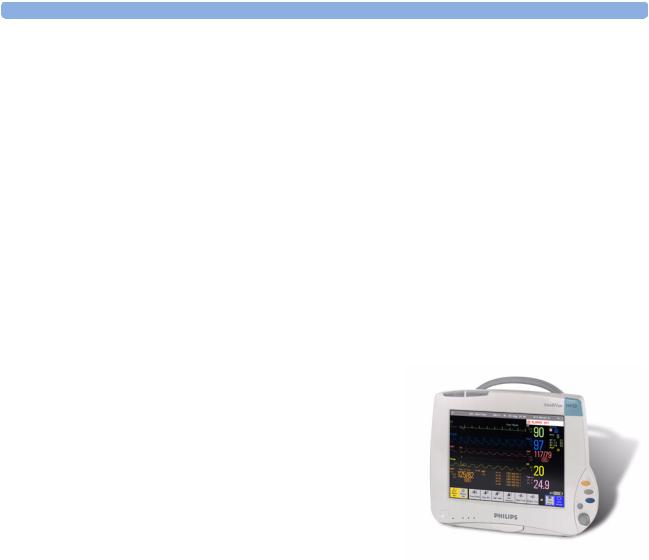
1 Basic Operation |
Introducing the IntelliVue Family |
Introducing the IntelliVue Family
The Philips IntelliVue family of patient monitors offers a monitoring solution optimized for the surgical, cardiac, medical and neonatal care environments. Combining patient surveillance and data management, it allows multi-measurement monitoring by linking separate modules with “plug-and- play” convenience.
Your monitor stores data in trend, event, and calculation databases. You can see tabular trends (vital signs) and document them on a local or remote printer. You can view measurement trend graphs, with up to three measurements combined in each graph, to help you identify changes in the patient’s physiological condition. You can view fast-changing measurement trends with beat to beat resolution and see up to four high resolution trend segments. Event surveillance enhances documentation and review of physiologically significant events by automatically detecting and storing up to 50 userdefined clinical events over a 24 hour period.
There is a choice of monitor configurations, as explained below. All models can also use computer devices such as a mouse, a trackball and a keyboard.
IntelliVue MP40/MP50
The IntelliVue MP40/MP50 (M8003A/M8004A) patient monitor has a 12-inch TFT LCD flat panel SVGA display. The standard input devices for the MP50 are the Touchscreen and integrated navigation point; the MP40 is supplied with an integrated navigation point only. Up to six waves can be shown on MP40/MP50 Screens, as well as the 12-Lead ECG Screen.
The MP40/MP50 can be connected to one MultiMeasurement Server (MMS) and any one of the measurement server extensions. The IntelliVue family plug-in measurement modules can be connected to its
four integrated plug-in module slots with plug-and-play convenience (the only exception is the SvO2 module, M1021A, which cannot be used with the MP40/MP50). The integrated module slots replace the Flexible Module Server (M8048A), which cannot be used with the MP40/MP50.
2
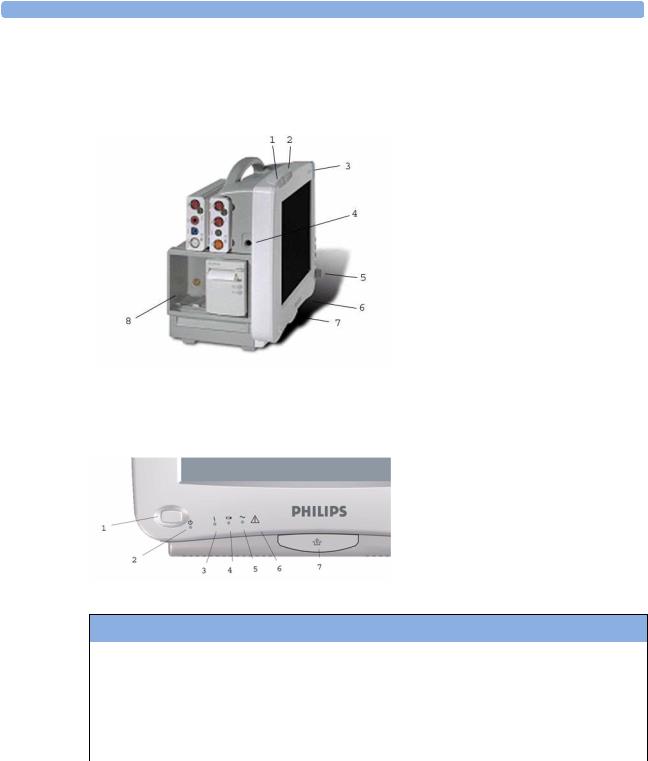
Introducing the IntelliVue Family |
1 Basic Operation |
MP40/MP50 Major Parts and Keys
MP40/MP50 left side
1 Color-coded alarm lamps
2 Alarms off lamp
3 Model indicator
4 ECG out
5 Navigation Point
6 Part number and serial number
7 Quick-release mounting release
8 Plug-in module slots
MP40/MP50 front panel |
|
1 |
On/Standby switch |
2 |
On/Standby LED |
3 |
Error LED |
4 |
Battery status LED |
5 |
AC power operation LED |
6 |
“read the documentation” symbol |
7 |
Mounting quickrelease lever |
MP40/MP50 LED Colors and their Meanings
On/Standby LED |
Green when monitor is switched on |
|
|
Error LED |
Red if there is a problem with the monitor |
|
|
Battery LED |
Green, yellow, and red. |
|
See the “Battery LED” on page 260 for details |
AC Power |
Green when monitor is connected to mains power |
|
|
3
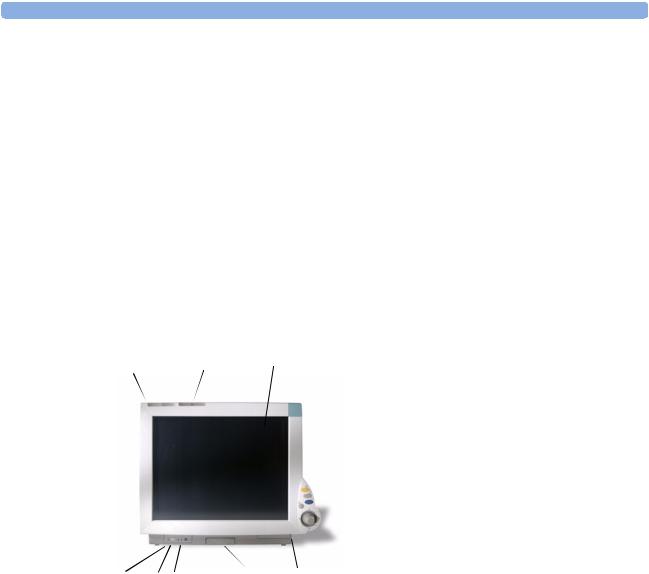
1 Basic Operation |
Introducing the IntelliVue Family |
IntelliVue MP60/MP70
The IntelliVue MP60/MP70 (M8005A/M8007A) patient monitors integrate the display unit, with a 15” color LCD display, and the data processing unit into one. Up to eight waves can be shown on the screens, as well as the 12-Lead ECG Screen. The MP60 uses the SpeedPoint as its primary input device while the MP70 uses touch screen operation but may have an optional SpeedPoint.
The monitors can be connected to the Multi-Measurement Server (MMS) and any one of the measurement server extensions, and to the Flexible Module Server (M8048A). The IntelliVue family plug-in measurement modules can be connected to its FMS module slots with plug-and-play convenience.
The MP60/MP70 has two integrated slots for plug-in modules. You can combine one each of the following modules in these slots: Pressure, Temperature, C.O., and VueLink. You can also use the twoslot recorder module in the integrated slots.
MP60/MP70 Major Parts and Keys
1 |
2 |
3 |
4 |

 5
5
11 |
10 |
9 |
8 |
7 |
6 |
|
1Color coded alarm lamps
2Alarms Off lamp
3Display
4Model indicator
5SpeedPoint (optional for MP70)
6Part number and serial number
7Mounting adapter release
8AC power LED
9Error LED
10Power on/standby switch
11Power on LED
4
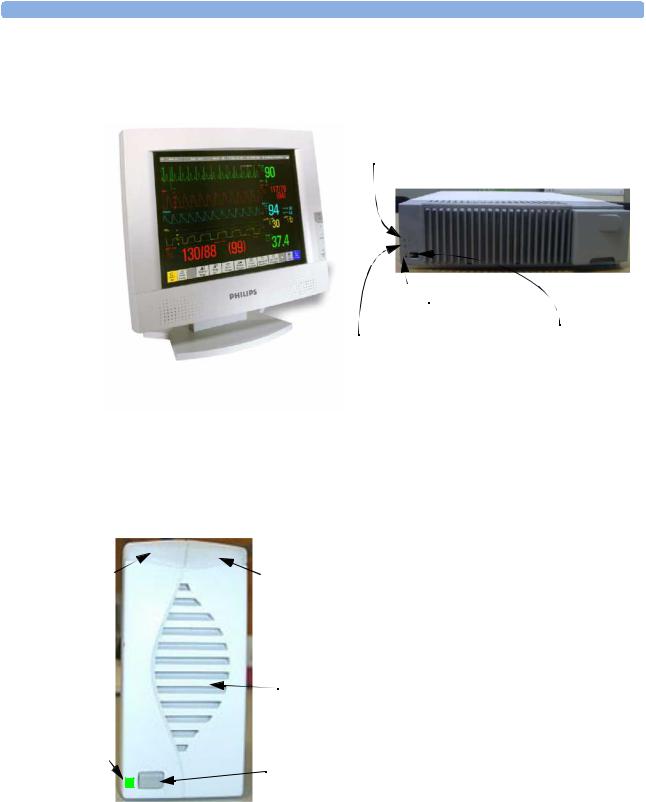
Introducing the IntelliVue Family |
1 Basic Operation |
MP90 Major Parts and Keys
In the MP90, the display and the processing unit are separate components. It offers both touchscreen and the Remote SpeedPoint as standard input devices.
AC Power LED
 Power on LED
Power on LED
Power on Switch
Error LED
Display Unit |
Processing Unit |
Remote Alarm Device
The Remote Alarm Device provides audio and visual indicators of alarms, in addition to those shown on the display.
1 |
2 |
|
|
|
1 |
|
|
2 |
|
3 |
3 |
|
|
|
|
|
4 |
5 |
|
5 |
4
Two color coded alarm lamps (right-hand lamp flashes red or yellow for patient alarms, left-hand lamp flashes light blue for INOPs)
Alarms off lamp - when illuminated it indicates that all patient alarms are deactivated.
Speaker - for alarm prompts, QRS tones and so forth
Monitor power on /standby switch. Press to switch monitor on remotely. Press and hold for one second to turn monitor off.
Power on LED - green when monitor is on
5
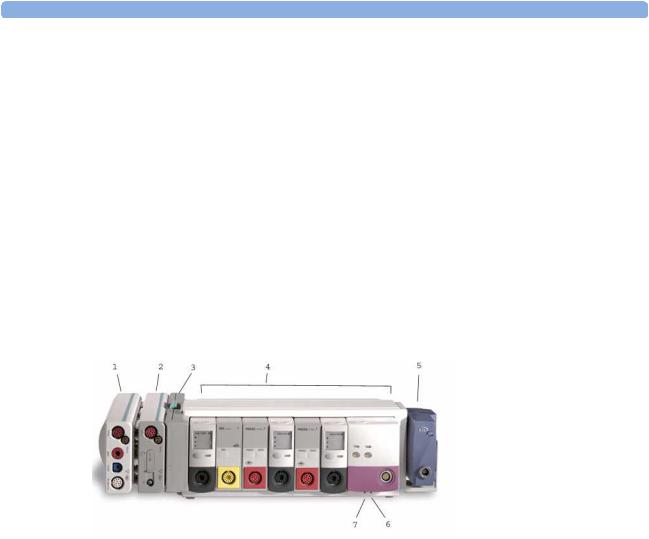
1 Basic Operation |
Related Products |
Related Products
Related products extend the measurement capabilities of your monitor. None of the related devices have their own power on/standby switches. They take their power from the monitor, and switch on automatically when you turn on the monitor. A green power-on LED indicates when they are drawing power from the monitor. A permanently illuminated, or flashing, red LED indicates a problem with the unit that requires the attention of qualified service personnel.
Flexible Module Server (M8048A)
MP60/70/90 only
The flexible module server (FMS) lets you use up to eight plug-in physiological measurement modules.
With the MP90 (M8010A) you can connect two FMSs to use up to 10 measurement modules.
Connect the FMS to the monitor via the measurement server link cable (MSL). Use the MSL connector on the left-hand side to connect additional measurement servers. Use the connector on the right to connect to the monitor.
1 Multi-Measurement
Server
2 Measurement server extension
3 Measurement server mount
4 Flexible Module Server
5 BIS engine
6 Power on LED
7 Interruption indicator
Measurement Modules
You can use up to eight measurement modules with the Flexible Module Server (M8048A), two additional modules in the integrated module slots in the MP60/MP70, and up to four in the integrated slots in the MP40/MP50. Available modules are:
•Invasive blood pressure, with up to five pressure modules simultaneously (M1006B)
•Temperature, with up to four temperature modules simultaneously (M1029A)
•Oxygen saturation of arterial blood (SpO2) (M1020B)
•Cardiac output (M1012A), and Continuous cardiac output with M1012A Option #C10
•Transcutaneous gas (M1018A)
•Mixed venous oxygen saturation - SvO2 (M1021A) MP60/70/90 monitor only
•Recorder (M1116B)
•VueLink device interface, with up to four VueLink modules simultaneously (M1032A)
•EEG (M1027A)
•Bispectral Index - BIS (M1034A)
6

Related Products |
1 Basic Operation |
You can plug and unplug modules during monitoring. Insert the module until the lever on the module clicks into place. Remove a module by pressing the lever upwards and pulling the module out. Reconnecting a module to the same monitor restores its label and measurement settings, such as alarms limits. If you connect it to a different monitor, the module remembers only its label.
The connector socket on the front of each module is the same color as the corresponding connector plug on the transducer or patient cable.
Press the Setup key on the module’s front to display the measurement’s setup menu on the monitor screen. When the setup menu is open, a light appears above the key. Some modules have a second key. On the pressure module, for example, it initiates a zeroing procedure.
Example Module (Pressure)
1Module name
2Setup key LED
3Setup key to enter setup menu of measurement modules or VueLink device data window
4Connector socket for patient cable/ transducer
5Second module-specific key, for example Zero
1
2
3
4
PRESS
Press
 5
5
7

1 Basic Operation |
Related Products |
Multi-Measurement Server (M3001A)
The Multi-Measurement Server (MMS) can simultaneously monitor 3-, 5- or 10-lead ECG (including arrhythmia and ST monitoring), respiration, SpO2, NBP and either invasive pressure or temperature. Depending on the monitor model, you can connect it to the monitor via a cable or mount it either on the left side of the FMS or on the back of the monitor, as shown here.
MMS mounted on rear of MP40/MP50 (left) and MP60/MP70
8
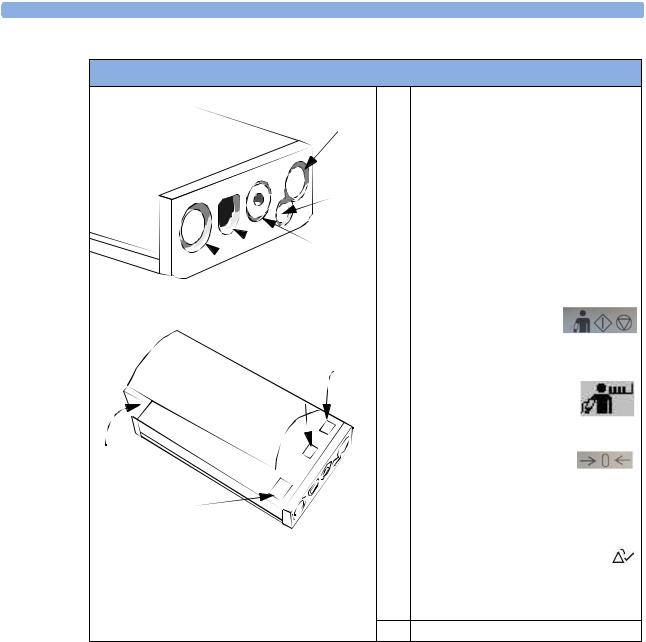
Related Products |
1 Basic Operation |
M3001A Connectors and Symbols
|
|
1 |
White ECG/Resp connector |
|
|
|
|
5 |
2 |
Blue SpO2 connector |
|
|
|
3 |
Red NBP connector |
|
|
|
|
|
|
4 & Combined pressure (red) and temperature |
|
4 |
5 |
(brown) connector - connect either invasive |
|
|
pressure transducer or temperature probe. |
||
|
|
|
You might have a version of the MMS that |
3 |
|
does not have this connector. |
|
|
|
||
2 |
|
|
|
1 |
|
|
|
|
|
|
|
|
|
6 |
|
|
|
|
NBP Start/Stop key - |
6 |
|
|
starts or stops NBP |
7 |
|
measurements |
|
|
|
|
|
|
|
7 |
|
|
|
|
NBP STAT key - starts NBP |
|
|
|
STAT series of |
|
|
|
measurements |
9 |
|
|
|
|
|
OR |
|
|
|
|
|
8 |
|
|
Zero key - initiates a zero procedure for the |
|
|
connected pressure transducer when |
|
|
|
|
pressed and held for a second |
|
|
|
|
|
|
8 |
|
|
|
|
Silence: acknowledges all active |
|
|
|
alarms by switching off audible |
|
|
|
alarm indicators and lamps. Takes behavior |
|
|
|
from SmartKey configuration |
9 MSL cable connector to the monitor
M3015A and M3016A Measurement Server Extensions
The optional M3015A Microstream CO2 Extension adds microstream capnography and either pressure or temperature to the MMS. The optional M3016A Mainstream CO2 Extension adds mainstream capnography and either pressure or temperature to the MMS. The measurement server extensions connect to the MMS and use the MMS settings and power.
The measurement server extensions must not be disconnected during monitoring. When the connection to the measurement server is broken, settings revert to default and any stored trend information is lost.
9
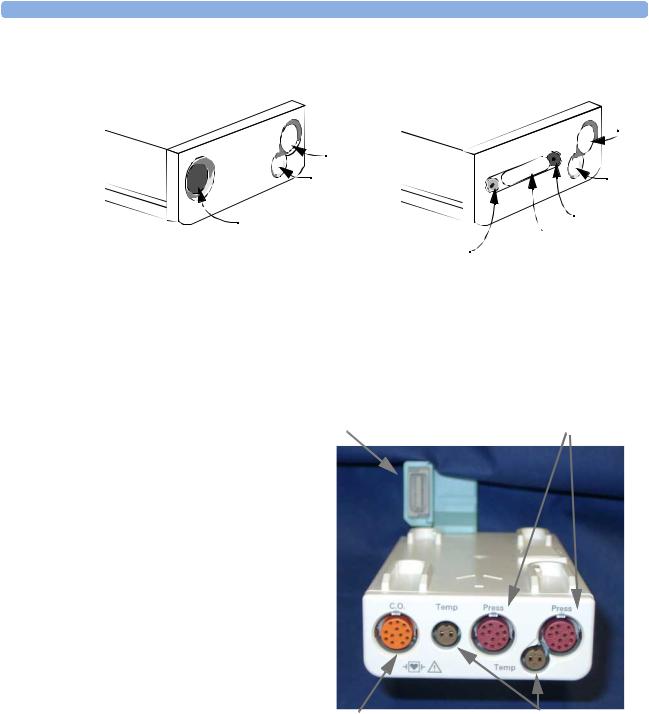
1 Basic Operation |
Related Products |
M3016A Mainstream |
|
M3015A Microstream |
|||
|
|
|
|
||
|
|
|
|
1 |
|
|
|
1 |
|
|
|
|
2 |
|
|
|
|
|
|
|
|
2 |
|
|
|
|
|
||
|
3 |
|
|
4 |
|
|
|
|
5 |
||
|
|
|
6 |
||
|
|
|
|
|
|
1 |
Pressure connector (red) |
4 |
Inlet |
|
|
2 |
Temperature connector (brown) |
5 |
Microstream connector CO2 |
||
3 |
Mainstream connector CO2 (optional) |
6 |
Gas sample outlet |
|
|
M3012A Hemodynamic Measurement Server Extension
The M3012A Hemodynamic |
Connection to MMS |
|
|
Measurement Server Extension |
|
(HMSE) can be connected to the |
|
M3001A Multi-Measurement Server to |
|
provide the following additional |
|
measurements: Temperature, Pressure, |
|
an additional Pressure or Temperature, |
|
and C.O. and CCO measurements. |
|
Pressure connectors (red)
Cardiac Output connector |
Temperature connectors (brown) |
(orange; optional) |
|
Anesthetic Gas Module (AGM)
See the AGM section of this Instructions for Use.
10

Operating and Navigating |
1 Basic Operation |
Operating and Navigating
Everything you need to operate the monitor is contained on its screen. Almost every element on the screen is interactive. Screen elements include measurement numerics, waveforms, screen keys, information fields, alarms fields and menus.
The configurability of the monitor means that often you can access the same element in different ways. For example, you might be able to access an item through its on-screen setup menu, via a hard key, or via a SmartKey. This Instructions for Use always describes how to access items via an on-screen menu. You may use which ever way you find most convenient.
1 |
2 |
3 |
4 |
5 |
6 |
7 |
8 |
9 |
 10
10
ABP Zero done at 11 Nov 02 7:31 am |
|
|
11 |
|||
18 |
17 |
16 |
15 |
14 |
13 |
12 |
Monitor information line |
Other screen elements |
||
|
|
|
|
1 |
network connection indicator |
10 |
alarm status area - shows active alarm messages |
2 |
bed label |
11 |
status line - shows information messages and prompting you for action |
3 |
patient identification |
12 |
close all open menus and windows and return to main screen |
4 |
patient category |
13 |
enter Main Setup menu |
5 |
paced status |
14 |
scroll right to display more SmartKeys |
6 |
date and time |
15 |
SmartKeys - these change according to your monitor’s configuration |
7 |
access the profiles menu |
16 |
scroll left to display more SmartKeys |
8 |
current screen name/enter |
17 |
Pause Alarms - pauses alarm indicators. Pause duration depends on monitor |
|
change screen menu |
|
configuration. If pause duration is infinite, this key is labeled Alarms Off. Select again to |
|
|
|
immediately re-enable alarm indicators. |
9 |
adjust volume/level indicator |
18 |
Silence - acknowledges all active alarms by switching off audible alarm indicators and |
|
|
|
lamps permanently or temporarily, if alarm reminder (ReAlarm) is configured on. |
|
|
|
|
11
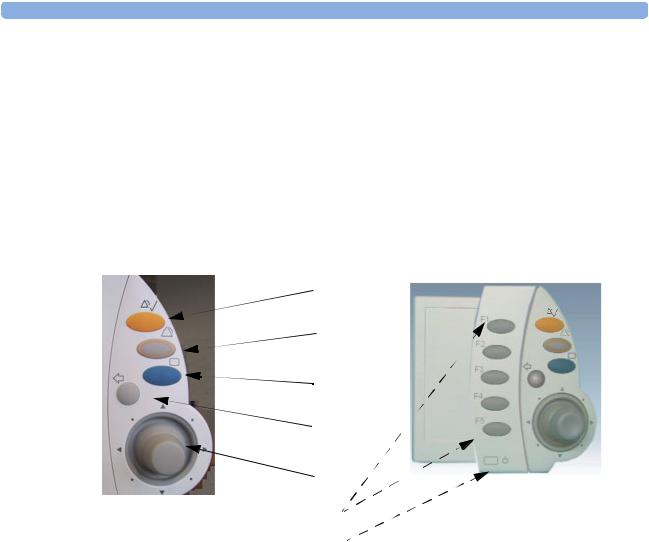
1 Basic Operation |
Operating and Navigating |
Select a screen element to tell the monitor to carry out the actions linked to the element. For example, select the Patient Identification element to call up the Patient Demographics window, or select the HR numeric to call up the Setup ECG menu. Select the ECG wave segment to call up the ECG lead menu. The network indicator and bed label elements show menus whose function is documented in the Information Center Instructions for Use.
Using the Touchscreen
Select screen elements by pressing them directly on the monitor’s screen.
Using the MP60/MP70/MP90 SpeedPoint
MP60/70/90
Only
|
|
1 |
|
|
|
2 |
|
|
|
3 |
|
|
|
4 |
|
|
|
5 |
|
|
SpeedPoint (MP60/MP70 |
6 |
|
|
|
Remote SpeedPoint |
|
|
only) |
7 |
|
|
|
||
|
|
|
|
|
|
||
1 |
Silence - acknowledges all active alarms by switching off audible alarm indicators and lamps. Behavior |
||
|
follows the Silence permanent key configuration. |
|
|
2 |
Alarms Off/Pause Alarms- pauses alarm indicators. Behavior follows the Pause Alarms permanent key |
||
|
configuration. |
|
|
3 |
Main Screen - close all open menus and windows and return to the main screen. |
||
4 |
Back - go back one step to the previous menu. |
|
|
5 |
SpeedPoint knob - rotate and tilt to highlight elements. Press to select. |
||
6 |
Function keys on remote SpeedPoint - function identical to the first five SmartKeys configured for a |
||
|
screen. |
|
|
7 |
On/standby key |
|
|
|
|
|
|
Rotate the SpeedPoint knob left or right. With each click, the highlight jumps to the neighboring screen element. Alternatively, tilt the knob to move it in the direction of a screen element. A cursor moves across the screen, following the direction of the knob. Any screen element under the cursor is highlighted. When you reach the screen element you want, press the knob to select the element.
Using the remote SpeedPoint, you can operate the monitor from a distant location such as at the foot of the bed. The remote SpeedPoint can also be used with the MP40/MP50.
12
